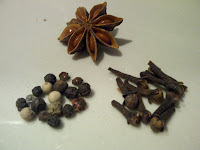This will produce a small batch (5 litres) of strong (~7%abv) warming ginger beer, not as sweet as Crabbies Ginger Beer but richer in maltiness.
Ingredients
1kg of dark or medium, dry malt extract (or 1.3kg of liquid malt extract)
300g root ginger
500g honey (optional, but will up the strength to nearer 8%)
Sachet of Ale Yeast
Method
Cut the ginger into small pieces and bash in a pestle and mortar (or in a freezer bag with a rolling pin)
Boil a litre of water in a large saucepan and add the bashed ginger and the malt extract.
Stir on a high heat until the malt has dissolved, it may form clumps until the water gets hot enough.
Once boiling and all the malt has dissolved, remove from the heat and add 4 litres of cold water, if using honey then add just before the cold water.

Please note: after boiling is over, any equipment coming into contact with this brew should be sanitised and this can be performed with a range of products from a home brew shop. If you can't get to a home brew shop, you could use a product for sanitising babies' bottles, but if you can't get to a home brew shop, you will probably also need to compromise on two other key ingredients by using bread yeast and ordinary malt extract. It will still work using these ingredients but the finished beer will not be quite as fine as if ale yeast and brewing grade malt is used.
Check the temperature, if above 22 C, place the pan in a sink of running cold water, stirring until the temperature comes down to a level that the yeast can cope with. This is usually stated on the pack of yeast, but for an ale yeast, this is typically 18-22 C. The stirring will serve to speed the cooling process and, if robust enough, will help aerate the malt solution (known as wort in brewing terms, pronounced "wert") dissolving gasses lost from the solution when boiled; An aerated wort is a better environment for the yeast to start-off in.

When at the right temperature, pour the wort into a sanitised fermenting bin. The fermenting bin or bucket is a food grade plastic bucket, but you can use a container of any food grade material, such as a glass demijohn or carboy. Sanitisation cleans the container to a level where there is near-as-dammit no microbes present to compete with the yeast for colonisation of the wort that is about to fill the bucket.
Once in the fermenting bin, add the yeast and stir vigorously for a minute to give the yeast a kick start. Place a lid loosely on the bucket, to prevent anything falling or crawling into the beer but not sealed, so the carbon dioxide gas produced from fermentation can escape. A sealed container would swell with built-up pressure and eventually blow making quite a mess. If desired, you could use a container fitted with a bubble trap which allows the gas to escape and better protects the beer from ingress of anything else, but this is not absolutely necessary - I hardly ever bother. However, the bubble trap will give you an indication of the progress of fermentation: the frequency of bubbling slows right down then stops when fermentation is over.

After a couple of weeks or when the fermentation is over you are ready to bottle the ginger beer. To be sure the fermentation is over, you should use a hydrometer and when the reading is low enough and stable for a few days, you can bottle.
As ever: sanitise bottles and equipment. If using a syphon tube, make sure the bits of ginger won't block it, by using an attachment that sits on the base of the fermenting bin that won't block, or by attaching a small piece of muslin cloth to the end of the tube.
Prime each bottle with household sugar at the rate of one teaspoon per litre of beer. Seal the bottles and leave at room temperature for a week for the sugar to be fermented to alcohol and carbon dioxide. Then leave in a cool or cold place for a few weeks for the carbon dioxide to dissolve in the beer, to carbonate it.
If you are unsure if the beer had fully fermented before bottling, use plastic bottles. If they blow, they will still make a mess, but not quite as scary as exploding glass bottles.
When ready to drink, handle the bottles gently so as not to kick-up the sediment and pour in a slow and smooth single motion, with light behind the bottle so you can see any sediment that may come with the last bit of the beer in the bottle.
Sit back and enjoy the beer, the maltiness and ginger giving a warm feeling on a cold day.

 Start cooking the pasta.
Start cooking the pasta.











































